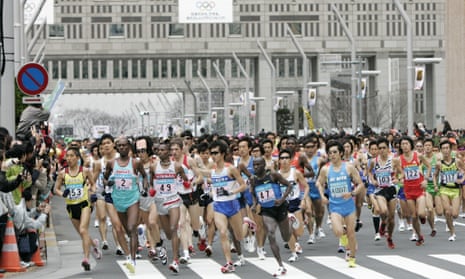Tokyo
Website: tokyo42195.org/2015en
How to enter: Free to register, and a lottery system to pick entrants. Less than a 10% chance, though – in 2013, 303,450 people registered and the cap was 25,000. Entry usually opens in the August before the race. Charity places are also available. FAQs here.
Fee: ¥10,800 (£59) for domestic entry, ¥12,800 (£70) for overseas entry
Next race: Sunday 22 February
History: First run in 2007, so the newcomer on the marathon block.
Course profile: Starts with a drop of around 37 metres (120ft) in the first 5.6km (3.5 miles), then flattens out. A few minor hills later in the race. A fair amount of turns.
Capacity: 36,000
Estimated spectators: 1.72 million
Course records: 2hr 6min 50sec (Dennis Kimetto, 2013); 2hr 25min 28sec (Atsede Habtamu, 2012)
Tips from local runners
Junko, Airbnb spokesperson: “Yoyogi park is my favourite running course in Tokyo. It is located near the Harajuku and Meiji shrines. I can run in a beautiful cherry blossom tunnel in spring, and also enjoy seeing the beautiful leaves change colour in autumn. After running, I always stop by the coffee shop or bake shop around the park for breakfast.” There’s your carb-loading sorted, then.
Airbnbs to stay in
Luxurious and quiet for pre-marathon relaxing, near Shinjuku, £73 a night
Centre of Tokyo, by the park for stretching out the legs, £71
Boston
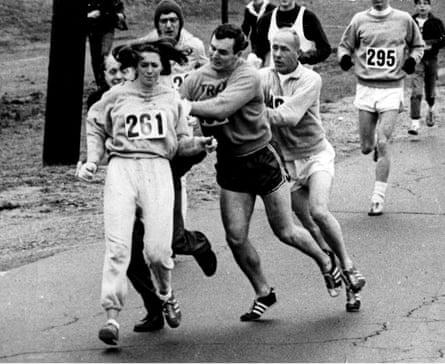
Website: baa.org
How to enter: Participants must meet a qualifying standard. Full details listed on the site but, as a guide, men in the 35-39 age category would need to prove a time of under 3hr 10min and women in the same age group 3hr 40min. This time does not guarantee entry: the fastest are accepted first until places are full. Entry opens usually in the September before the race.
Fee: $175 (£112) domestic, $225 (£143) international
Next race: Monday 20 April
History: The world’s oldest annual marathon started in 1897. The place where 19-year-old Katherine Switzer changed the rules. It’s got all the history.
Course profile: A point-to-point course with a considerable overall elevation drop of 104 metres (480ft), which is why it’s not eligible for a world record under IAAF rules (handy to know if you are world record holder Dennis Kimetto …), but gives you excellent PB potential.
Capacity: 27,000
Estimated spectators: 500,000
Course records: 2hr 3min 2sec (Geoffrey Mutai, 2011); 2hr 18min 57sec (Rita Jeptoo, 2014)
Tips from local runners
Kate, Airbnb host, Boston: “I love running around Jamaica pond in Jamaica Plain, as well as around the Chestnut Hill reservoir. Other popular and beautiful runs around Boston are the paths along the Charles river (both sides) and through the parks of the Emerald Necklace, which contains Jamaica pond, and stretches from central Boston through JP, Roslindale and Roxbury.”
Airbnbs to stay in
Boston studio near the river, nice sofas for stretching those legs on, Beacon Hill, £112
Lovely luxury studio near some beautiful walks to stretch those sore legs, $119
London

Website: virginmoneylondonmarathon.com
How to enter: Ballot entry for mass participation. Good for age and championship entry for faster times, and places available via approved tour operators for overseas entrants. There are charity places aplenty, and running clubs are usually given a few spots each.
Fee: £35 (domestic ballot entry). For overseas entries, cost depends on the tour operator.
Next race: Sunday 26 April 26
History: First run in 1981
Course profile: A big drop of around 37 metres (120ft) between miles three and four, otherwise pretty much flat. Fairly twisty though, particularly between miles 14-21.
Capacity: 36,550
Estimated spectators: 750,000 (unless Mo is running …)
Course records: 2hr 4min 29 sec (Wilson Kipsang, 2014); 2hr 17min 42sec (Paula Radcliffe, women only, 2005) or 2hr 15min 25sec (Paula Radcliffe, mixed race, 2003 – pick your world record)
Tips from local runners
Holly, acting country manager for Airbnb UK: “One of my favourite loops to run is around Hampstead Heath. Starting at Kentish Town underground station, you make your way on to Hampstead Heath and you immediately forget you’re in the heart of a city. The huge, hilly park is secluded, covered in woodland and offers incredible views of London.” Richmond park offers a larger alternative in south-west London (a circuit is just over seven miles).
Airbnbs to stay in
A gym to stretch legs in beforehand, and a hot tub to ease aches after. Perfect. £65
Berlin
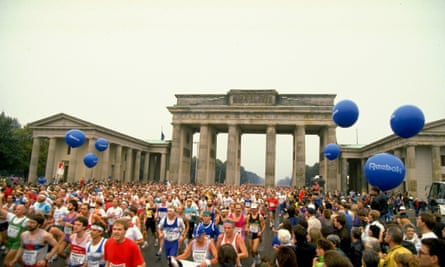
Website: bmw-berlin-marathon.com
How to enter: Ballot entry (open in the October/November before the race) or fast entry with simple criteria – sub 2hr 45min for men under 45, sub 2hr 55min for 45 and up. For women, it’s sub 3hr for under 45, and sub 3hr 20min for over 45. Tour operator places and charity entries also available.
Fee: Flat rate for all of €98 (£78)
Next race: Sunday 27 September
History: Started in the Grunewald forest in 1974, moved to West Berlin in 1981. The 1990 edition of the race was run three days before unification – runners streamed through the Brandenburg Gate, many in tears. The most world records have been set on the streets of Berlin.
Course profile: Flat and fast. Enough turns to keep it interesting, but not to detract from speed: it is the world record course for a reason. Start and finish only half a mile apart, which makes it logistically simple.
Capacity: 40,000
Estimated spectators: 1 million
Course records: 2hr 2min 57sec (Dennis Kimetto, 2014, also the world record); 2hr 19min 12sec (Mizuki Noguchi, 2005)
Tips from local runners
Bonno, Airbnb spokesperson: “My top training spots:
1. Airport Berlin Tempelhof – This former airport is open to the public and is the perfect place for long runs. Berliners hang around here and skate or bike around the former airstrips. Cars are not allowed.
2. Tiergarten – This is the most popular place to go for a run. The park is really big and the forest track is very healthy for your knee joints. However, Tiergarten is separated through streets which can be disruptive while running, therefore I prefer to stay in the largest part in the south-west.
3. Friedrich-Ludwig-Jahn-Sportpark – this is a sports complex with a stadium and several smaller sports fields. There is an open running track around one of the soccer fields and runners gather there in the evening.
4. Follow the Spree – it’s great to run along the Spree river. Starting at the German chancellery, pass the house of the cultures of the world and the Bellevue palace.”
Airbnbs to stay in
Museum island, right in the middle of Berlin, £40
Mitte apartment in a gallery, £61
Chicago
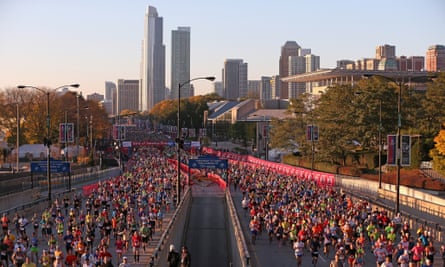
Website: chicagomarathon.com
How to enter: Lottery entry (closes in the April before the race), or charity entry for a guaranteed place. Qualifying time entry for faster runners: sub 3hr 15min for men or sub 3hr 45min for women.
Fee: $185 (£118) for US residents, $210 (£134) for overseas
Next race: Sunday 11 October
History: Run annually since 1977, though an earlier iteration started in 1905, petering out in the 1920s.
Course profile: Fast and flat on the shores of Lake Michigan – second to Berlin in number of world records. Start and finish also close, which makes logistics easy.
Capacity: 45,000
Estimated spectators: 1.7 million
Course records: 2hr 3min 45sec (Dennis Kimetto, 2013); 2hr 17min 18sec (Paula Radcliffe, 2002)
Airbnbs to stay in
Spacious loft near the beach, £130
Private room/bathroom with swimming pool, tennis court and fitness centre, £67
New York
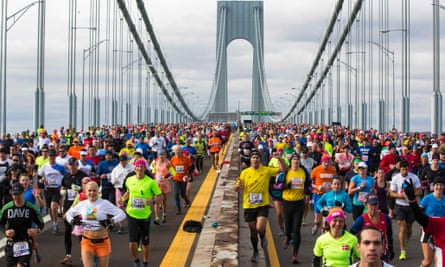
Website: tcsnycmarathon.org
How to enter: Entry via ballot (entries for next year open 15 January to 15 February 2015), for which there is a non-refundable $11 processing fee. There are three categories within the lottery: runners from the New York City metro area, runners from elsewhere in the United States, and foreign runners who aren’t part of an international tour group. There is also entry via qualifying/“fast” times, which are broadly similar to London Marathon’s “good for age” times. More details here.
Fee: (Brace yourself) US residents: $255 (£162) or $216 (£137) for NYRR members. Non-US residents: $347 (£221)
Next race: Sunday 1 November
History: First run in 1970, entirely in Central Park. The entry fee was $1. There’s inflation for you.
Course profile: A point-to-point course which travels through all five boroughs. Hills throughout, largely in the form of bridges. Start on Staten Island, which presents logistical issues for many.
Capacity: 58,000
Estimated spectators: Around 2 million
Course records: 2hr 5min 6sec (Geoffrey Mutai, 2011 ); 2hr 22min 31sec (Margaret Okayo, 2003)
Tips from runners
Michael, Airbnb host: “I train a lot in Central Park: hill repeats on Cat Hill or the Harlem Hills. 800m and 400m speed work around the Great Lawn or lower loop near the marathon finish. Fartleks around the Jacky O reservoir. I take speed classes with JackRabbit sports. My favourite run is a 22-miler that goes into three boroughs: start in Astoria, run over the Tr-borough RFK bridge into Randal’s Island, then one loop of the island, through the marshlands, past Ican stadium and over the 125th Street bridge into Manhattan, then down the east river path to 59th street, cross to 2nd avenue and run it south all the way to the Manhattan bridge (plenty of parks along the way with water fountains), cross the Manhattan bridge into Brooklyn, then cross downtown Brooklyn to Cadman Plaza and run back into Manhattan over the Brooklyn bridge, then over to Broadway and run up Broadway all the way to end at Columbus Circle. You can alter this if you want to run on the west side Hudson river paths to Columbus Circle.”
Where to stay
Charming brownstone, 100ft from Central Park, £149 (perfect for the painful post-marathon stagger home)
Quiet Manhattan room, a short distance from Brooklyn bridge, £64
